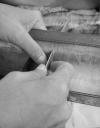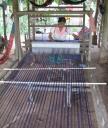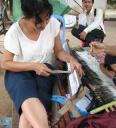
So…with our MFI (Maxima), we visit a lot of people who make a living by weaving cloth. With extant samples of hand-woven cloth dating from 5000 BC, weaving must be one of the world’s oldest ways to make money.
More than two hundred years ago, the Industrial Revolution introduced processes that, to this day, have passed by the villages and the people we visit. The looms that Maxima’s clients use are hand-made and the technology has not changed for many decades if not longer.
There appears to be a range of skill levels and ambitions among loom operators. Some weave simple, one-color cloth. Some weave with blends of different thread – silk, cotton or nylon. Some weave cloth with a pattern that runs down one long side. Occasionally, we see some working looms with many suspended ‘templates’ that separate the threads of the “warp” allowing the weaver to create complex patterns. (The following photo shows a loom with many templates.)
It can take years to learn to weave high-quality cloth. Watching the ladies (and occasional man) work made we wonder about how they even get started. By this, I don’t mean how they learn to weave. I mean how the loom gets set up before any weaving can take place.
Our loan officers talked about “preparing” the loom but I’d never seen this process. I was clueless as to what might actually be involved until one day we drove past two women sitting on a small platform in front of a house (see second photo above). They were in the process of setting up a loom. We stopped for a closer look and I was fascinated by the complexity of the work. Thread, often cotton or silk, needs to be stretched between two parallel wooden rods or boards and maintained with equal tension (see first photo at top and photo below). These longitudinal threads are called the “warp”. With the looms in this area, the warp typically spans a distance of three meters and is eighty or so centimeters wide.

Between each wooden anchoring rod are templates or walls of vertcal separating strings which I think are called “heddles” (see photo). The loom preparer winds bulk thread around the board at one end of the loom, threads it string-by-string through the templates or heddles.
The threads are each strung again through a comb-like piece of flat metal that is used to beat the “weave” thread uniformly into place. (see following photo) This process requires two people, a specialized hook tool and what must be fantastic eyesight….not to mention phenominal patience.
 The teeth or tines of the comb (which I think is called the “reed”) are so finely cut that you can see through them. Over the width of this reed there were 2,600 threads . . . each one threaded, tied and tensioned equally!
The teeth or tines of the comb (which I think is called the “reed”) are so finely cut that you can see through them. Over the width of this reed there were 2,600 threads . . . each one threaded, tied and tensioned equally!
A typical loom takes a month to set up and can be used for perhaps three to four. For this . . . the loom preparer makes about (US) $30-$40! Amazing…
If you’re curious about more Cambodian weaving information, you can see any of these links:
http://en.wikipedia.org/wiki/Cambodian_clothing
http://query.nytimes.com/gst/fullpage.html?res=9B05E2DD163FF933A15757C0A961958260
http://www.leisurecambodia.com/Leisure_Cambodia/No.07/culture.htm
http://www.eicambodia.org/events/upfile/EXPORT_DIVERSIFICATION_VALUEADDITION_by_Vuthy.pdf
/>PREVIOUS ARTICLE
Check out Kiva.org on CNBC's "Business Nation" tonight! →NEXT ARTICLE
Vote for Kiva! →



















